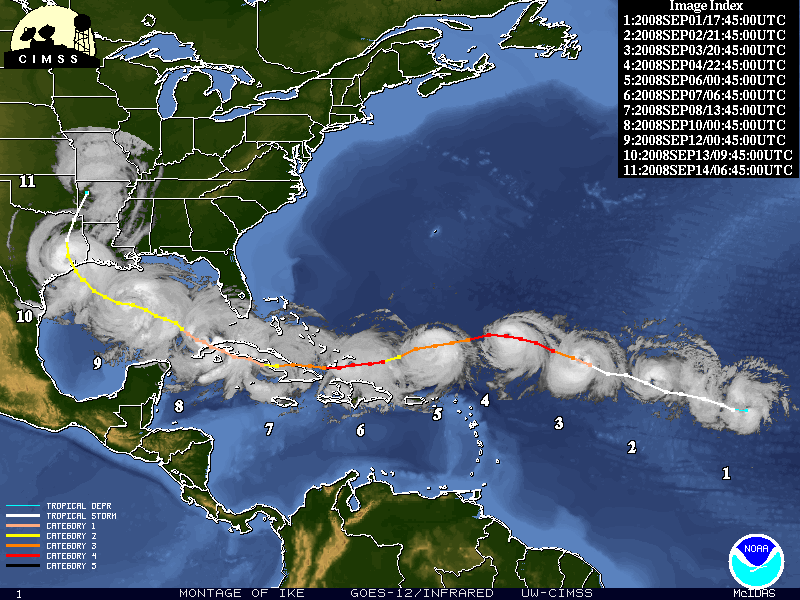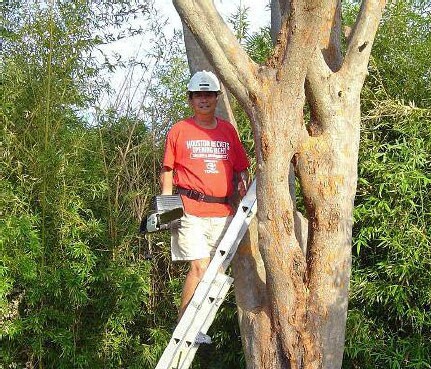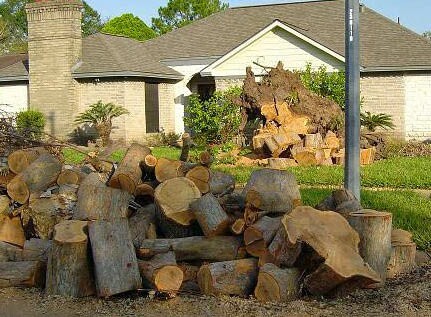The
Ike Experience

Ike,
not Ike as in Eisenhower, but Ike the Hurricane. It was the most massive
storm, nearly the
size of
A
hurricane is a tropical cyclone with closed
circulation
around a
center of low pressure that is fueled when moist air
rises, condenses
and
releases heat. It
circulates
counter-clockwise in the northern hemisphere about its
center, the eye. In
simple imagery, divide the hurricane into
two halves and four quadrants: the
east
is the dirty side and the west is the clean side. The
lower right quadrant has the second most
surge, rain and wind gusting from the southwest; the
front right
quadrant will
have the peak wind and maximum surge delivering the
most damage t with
winds
coming from northeast; the front left quadrant will
have lesser effects
of the previous
two quadrants as the water-laden winds have already
deposited most of
the
moisture with wind predominantly coming from the
northwest; the lower
left
quadrant will be least affected, relatively, with wind
blowing from the
northwest. Understanding
this cyclic
wind mechanics, one could minimize the damages,
particularly in
determining
what directions to board up windows with plywood,
which was acutely
short of
supply at Home Depot. Had
Ike made a
landfall at
I put
up all the hanging plants and garden furniture and
disassembled
the gazebos. In addition
to stocking up
food, batteries, portable air pumps, water, filling my
bathtub and
gassing all
my cars, I even cooked a huge slab of corn-beef in a
crockpot. Sue Ann did all
the laundries. I will
explain these activities later
on. I fed my koi and bade
them good
luck. We had a good
dinner and washed
all the dishes. It was
typically the
calm before the storm. We
crouched
around to watch the direct telecast of the imminent
storm.
Not
as many Houstonians fled to Austin,
Ike
made landfall on
The
gust reached
It
was like a battleground. Nature
had
vanquished and we were defeated.
The
whole city was without power and with it
out went the TV, refrigeration, air conditioning,
water, mobile and
telephone land
lines, internet, running water, and all the amenities
propelled by
electricity. My handheld
battery
operated TV informed us that we were to have a tough
time ahead. A tough time,
indeed, 90 % humidity and 90˚ F
prevailed. The cooked
corn-beef, the
good old fashion way of preserving meat centuries ago
prior to
refrigeration,
came in handy. I
barbequed the thawed
out chicken wings for dinner. But
the
night was unbearably long and boring.
I
now can empathize with people of the pioneer
days—early to bed and
early
rise. I missed my late
night shows,
I almost forgot the poor koi while clearing debris in the backyard. The aerator and filter had ceased to function 24 hours ago. With exceptional understanding, the koi hid underneath the footbridge for shade. They came up for air and longed to be patted, as I would normally do every morning before feeding. I cleared the fallen twigs from the water and rigged up portable air pumps, using D-batteries for their survival. Man, were they ever relieved!
Sunday
night was the autumn moon festival.
The moon seemed extraordinary bright and full
because of the darkened background of the whole city. While amusing myself sitting
on the deck
underneath the battered arbor, the lights came on at
precisely
This
sudden windfall of electrical power was too much to
bear. We closed all the
windows so as to
enjoy the
air-conditioning and promptly cooked a hearty supper
to supplement my
corn-beef
and cabbage dinner earlier. We
even cut
the moon cake to celebrate the occasion.
Our
tap water was still at a trickle.
We had
to take a shower virtually by drops and flushed the
toilet using
the water we filled in the bathtub three days earlier. Because of low pressure, the
City advised us
to boil water for fear of contamination.
Now,
we went back to modern day life style and slept
soundly for the
night. I wondered how
many millions of
Houstonians were still suffering.
Upon learning that we were the chosen few in these darkened days, friends and relatives began to descend upon us for favors, which we were more than happy to oblige. They brought their half-melted frozen food items to store in our freezer. We would make ice for them to take back so as to prolong their dwindling food reserve in their coolers. For a while, our house was much like a quasi take-out food services and Laundromat, as some even brought their soiled underwear and clothing to take advantage of our washer and drier. Remember, we did dish washing and laundries a few hours before Ike arrived.
For
those who voluntarily evacuated a few days earlier
now came back
to find out, among other damages, their power had been
off all the time. The
musty, un-circulated air inside and the
foul
odor from spoiled food dampened their welcoming home
spirit. Needless
to say,
they were in a real dilemma—no food and nowhere to buy
food; low on
fuel and
didn’t dare to drive around to search for fuel. We
gave some of them surplus food. The
mandatory
returnees from

Urban Lumberjack Frank
For
the last seven days, I, with chain-saw and hard hat,
reduced the
downed branches to manageable size and hauled them out
by the curbside. The pile
measured 5’x15’x7’, an impressive
buildup, no matter what. I
followed the
instructions: tree waste, trash, and wooden fence
separately. An

My Poor Neighbor
For
the last 10 days, I worked as a janitor, gardener,
urban lumberjack,
carpenter and whatever chores, from dawn till dusk,
around the house to
restore
it back to its pre-Ike days. Direct
hit
of hurricane occurs once every 25 years.
We
don’t have earthquakes as in
Frank Yu, Houston